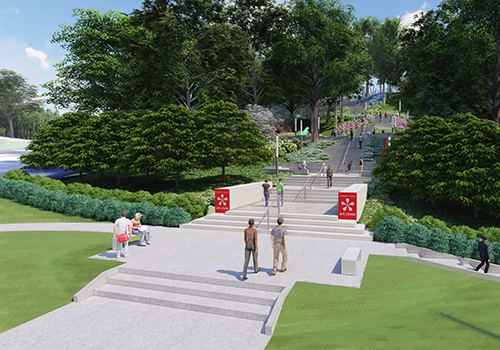posted by Kate Kennedy ON
Feb 21, 2020

The Cincinnati Art Museum has sat at the top of Eden Park since it was first built in 1886. That location gives the building prominence and provides beautiful views of the surrounding region, but there's a downside. Despite sharing a border with five vibrant downtown neighborhoods (Walnut Hills, Mt. Adams, Mt. Auburn, Pendleton and Downtown), none of them has had an easy path for residents to walk in or to visit. This year, that's going to change when the new, welcoming entrance, Art Climb opens.
Louis and Louise Dieterle Nippert Museum Director Cameron Kitchin knew that physically connecting the neighborhoods to the museum was important, noting that the museum’s mission is to “inspire people and connect communities through the power of art, making a more vibrant Cincinnati," To do this, though, required years of planning, beginning with a site master plan developed in 2015. Working with the museum board, Kitchin sought input from consultants, community development agencies and over a thousand surveys from museum members and volunteers. They found support for the project from ArtsWave, along with the Haile Foundation, the Cincinnati Development Fund, the Walnut Hills Area Council and the Mt. Adams Civic Association. All signs and advisers pointed the museum toward universal accessibility, direct public service and a new vision of community interaction with art. The Art Climb was conceived in the spirit of fulfilling that vision.
The Art Climb will feature a staircase from the sidewalk near the intersection of Eden Park Drive and Gilbert Avenue that leads up to the front museum entrance. The goal of the project is to open up the museum grounds, connect the museum to its neighbors and provide a space to incorporate outdoor artworks. It's the latest in a series of steps that the museum has taken to become more accessible and inclusive to the public. Most notably, the museum recently finished construction on a handicap-accessible ramp at their main entrance. Public response has been overwhelmingly positive so far, with one patron responding in a survey, "I was getting choked up about being able to share my childhood art museum with my son."
CAM is not alone in their endeavors to become more inclusive. Its neighbor Cincinnati Playhouse in the Park is taking its own steps toward inclusiveness. Playhouse has been known to stage challenging works that explore cultural differences. When they staged the Pulitzer Prize-winning drama "Disgraced" in 2016, Playhouse began holding nightly audience discussions after productions with strong, relevant social themes. That tradition continues with the recent productions of "americUS" and "Actually." Patrons overwhelmingly report increased empathy and understanding in surveys. "Theater is uniquely situated to help you see the world through other people's eyes," explains Cincinnati Playhouse in the Park Artistic Director Blake Robison.
During their production of "The Thanksgiving Play" by Larissa Fasthorse, Playhouse in the Park added a Land Acknowledgment statement to their programs, complete with a map outlining the tribes that once inhabited the Greater Cincinnati region. That statement, crafted in collaboration with the Greater Cincinnati Native American Coalition, remains in place today. The partnership with the GCNAC has grown, as well. In February of 2020, they worked with Playhouse in the Park on a "Red Dress" installation, bringing attention to a national crisis of missing and murdered indigenous women and girls.
To further welcome the public, Cincinnati Playhouse in the Park implemented a $10 Tuesday initiative, designating 100 tickets to be made available on a pop-up basis for those who wouldn't otherwise be able to afford a ticket to popular plays. Playhouse is also constructing a new theater, and much like the Art Museum's recent projects, they're taking community inclusiveness into account. Robison refers to the design as "Park in the Playhouse," as the plan includes connecting the building to Eden Park more thoroughly just as the Art Climb does. In fact, the two organizations are in talks about how they can work together to open walking paths to both venues. The new theater will also feature a plaza with seating, a small stage and a playground for younger audiences.
Cincinnati Ballet is in the midst of their own major new construction. Their new headquarters will be in Walnut Hills, "along a major city artery" to make it "accessible and visible," says GBBN Chief Executive Officer Matthew Schottelkotte. "The building’s transparency celebrates the activity within. People outside can see what’s going on in the studios." The same philosophy was put into practice in 2017 with Cincinnati Shakespeare Company's new theater. The rehearsal room is prominently placed in a corner, facing the public with glass walls to invite the attention of neighbors.
CAM, Playhouse and the Ballet have also been among the leaders of another kind of inclusive movement. Joining organizations like The Children's Theatre of Cincinnati, Ensemble Theatre Cincinnati, Cincinnati Museum Center, the Contemporary Arts Center and more, each organization offers sensory-friendly programming for those with developmental disabilities or those on the autism spectrum. The crux of these programs is providing a judgment-free zone, where patrons can enjoy the arts without any anxiety about feeling disruptive. This is an important step toward inclusiveness for the arts sector, as traditional rules that are often enforced at performances can sometimes exclude large groups of people.
Similarly, Cincinnati Opera, Cincinnati Symphony Orchestra and Cincinnati Arts Association participate in the Starting Our Adventure Right (SOAR) program, Cincinnati Children's Hospital and Medical Center's initiative to improve community inclusion for people with developmental disabilities and their families.
All around Greater Cincinnati, the arts are taking intentional steps toward connection with their surrounding neighborhoods and the populations they serve. As they strengthen those connections, they strengthen their own relevance, ensuring that our region will continue to benefit from a robust arts scene for generations to come.